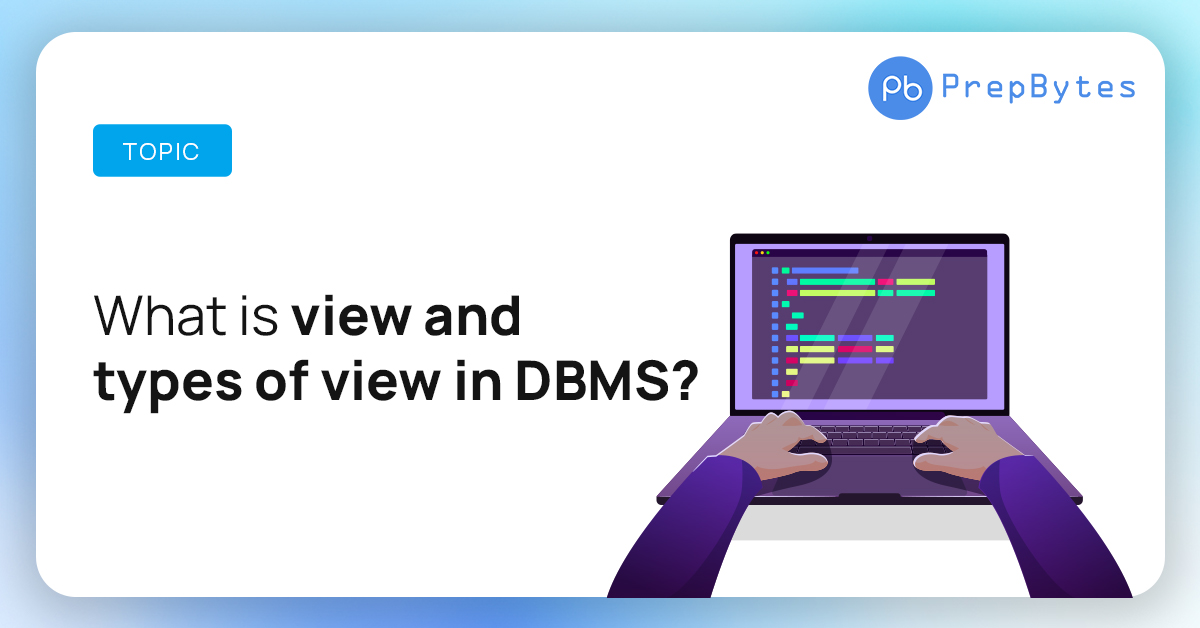Last Updated on August 25, 2023 by Mayank Dham

Within this article, we shall explore the purpose and functionality of a view in DBMS (Database Management Systems). Additionally, we will delve into the methods to obtain data views within a DBMS. Furthermore, we will examine the various categories of views accessible to users in DBMS. Lastly, we will address commonly raised queries concerning data views in DBMS before concluding.
View in DBMS
View in dbms are virtual table obtained as a result of a query in SQL i.e. Structured Query Language. Whenever the end-user requests the data according to specified needs rather than complete information of the table.
A view of data in DBMS is created to display the specific information that a user needs, rather than revealing sensitive portions of the schema that should remain confidential to the owner. Essentially, the data view in a DBMS presents a selective representation instead of exposing the complete database. It’s important to note that any modifications made to the database will also be reflected in the corresponding view.
How to get a view of data in DBMS
Acquiring a view in DBMS involves formulating a set of statements designed to extract specific elements from the database. These statements then construct a table on the user’s device, organizing the outcomes in a tabular format. The pseudocode to obtain a data view can be outlined as follows:
create
view view
as
select columnName1, columnName2,...
from tableName
where condition;Let’s suppose we want to get the data for a student’s performance in a particular subject in the recently held exam. We can get the information view in dbms.
create
view view
select marks from student
where uniqueID = 1221;Now that we have clarity on how to create a view of data in dbms, we will move forward on how to drop or delete a view in dbms in the upcoming sections of this article on View in DBMS.
Dropping a view in DBMS
If there arises a need to eliminate an existing generated view, the option to do so involves utilizing the "DROP" command within the Structured Query Language (SQL). This command facilitates the removal of the specified view from the database.
Let us look at an example along with the code on how we can drop a view in dbms.
drop view NameView;Reasons to Use View in DBMS
Views are at advantage as the view of data in dbms is restricted to only a subset of the entire database or in a sense, “Ask as per your requirements” is the principle on which view of data in dbms is based upon.
Another advantage to using View in dbms is that it merges information from multiple tables to show what the user requires.
As they are computing and creating output for the user, they require no additional storage unlike the data stored in the database.
Views are able to present to aggregated data such that for measure purpose, we can get the sum, count and average of values spread over different tuples in schemas.
One of the major reasons to use view is that it provides security and no unauthorized access or bypass can be performed and information services can run as usual.
Conclusion
Understanding views in DBMS is essential for data organization and security. Views allow users to access a tailored subset of data while keeping sensitive parts of the schema hidden. The different types of views cater to various user needs, from simplifying complex queries to enhancing data security. Mastering the concept of views empowers users to effectively manage and manipulate data in a way that suits their requirements.
Frequently Asked Questions on View in DBMS
Below are some of the FAQs related to View in DBMS:
1. What is the purpose of using views in a DBMS?
Views offer a means to present a customized and controlled perspective of the database to users, without revealing sensitive information. They simplify data access and enhance security.
2. Are views physically stored as separate tables in the database?
No, views are not physically stored as tables. They are virtual tables that derive their content from the underlying base tables and are generated dynamically when queried.
3. Can views be modified like regular tables in a DBMS?
Views are typically read-only, meaning they can’t be directly modified. However, some DBMS systems allow for updatable views with certain restrictions, enabling limited modifications through the view.
4. How do materialized views differ from regular views?
Materialized views store the actual data temporarily, making them faster for querying but requiring synchronization with the underlying data. Regular views don’t store data; they retrieve it on demand.
5. What is the difference between a virtual view and a materialized view?
A virtual view is generated on-the-fly when queried, whereas a materialized view stores data persistently, requiring periodic refreshes to ensure data consistency.
6. Can I create a view that spans multiple tables in a DBMS?
Yes, you can create complex views that involve multiple tables. These views simplify queries involving joins, aggregations, and other operations across multiple tables.
7. Can views improve database performance?
Yes, views can enhance performance by simplifying queries and encapsulating complex logic. Materialized views, in particular, can significantly boost query speed.


